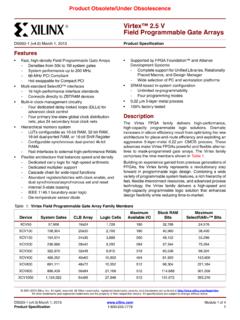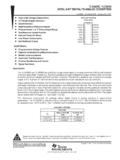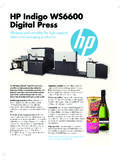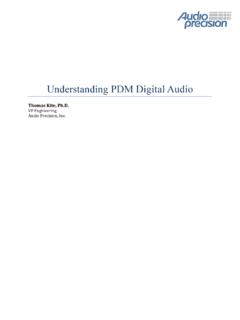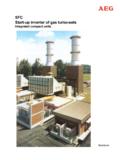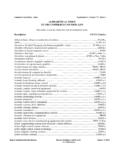Transcription of Xilinx XAPP1113 Designing Efficient Digital Up and Down ...
1 XAPP1113 ( ) November 21, 1 2008 Xilinx , Inc. All rights reserved. Xilinx , the Xilinx logo, and other designated brands included herein are trademarks of Xilinx , Inc. All other trademarks are the property of their respective Up Converters (DUC) and Digital Down Converters (DDC) are key components of RF systems in communications, sensing, and imaging. This application note demonstrates how Efficient DUC/DDC implementations can be created by leveraging Xilinx DSP tools and IP portfolio for increased productivity and reduced development time. While previous application notes [Ref 1] have provided examples of DUC and DDC implementation in wideband communications systems, this document concentrates on narrowband systems and the building block components available to meet the particular requirements of such guidance is provided on how to perform simulation of narrowband DUC/DDC systems in MATLAB , how to map functions onto building blocks and IP cores for Xilinx FPGAs in System Generator software, and how to verify the implementation against the simulation model.
2 Two examples are provided: a multi-carrier GSM system (both DUC and DDC) and a multi-channel MRI receiver (DDC only). The examples provide a guide and template for implementation of customer-specific solutions and, in many cases, may be readily adapted to customers own application systems. Advantages and limitations of the approaches and methods employed are identified such that the reader can consider these in their own system terms of signal processing, narrowband systems are generally characterized by the fact that the bandwidth of the signal of interest is significantly less than the sampled bandwidth; that is, a narrow band of frequencies must be selected and filtered out from a much wider spectral window in which the signal might occur.
3 This means that large sample rate changes (in the hundreds or even thousands) must be undertaken to efficiently process the signal for either transmission or reception. Examples of such systems include: communications systems, where several narrow channels must be recovered from a wider transmission band, or medical imaging systems, such as MRI, where the detected waveforms occur in a narrow range of frequencies at varying points within a wider spectrum, as well as many other systems that fall within this grouping.[Ref 1] deals with wideband systems, providing guidance on how to select an appropriate cascaded FIR structure to meet the sample rate change requirements of wireless base stations.
4 When the desired sample rate change is 32 or more, it is advisable to consider the use of CIC filters. CIC filters are an alternative class of filters to FIR filters, and they are well-suited to large sample rate changes, as they can be implemented efficiently in Digital circuits. They are often used in conjunction with small Finite Impulse Response (FIR) filters to implement the filter chain of up- and down-converters in narrowband systems. While such converters have been implemented often for many years in both Application Specific Standard Products (ASSPs) and FPGAs, these have generally provided only single-channel solutions, or multiple instances thereof.
5 The latest high-density FPGA families with advanced architectures, in combination with Efficient IP cores and effective design tools, provide the capability to handle many channels simultaneously. This application note demonstrates how to implement such : DUC and DDC design files for 4-carrier GSM, targeting Virtex -5 FPGAsApplication Note: Virtex-5 Family XAPP1113 ( ) November 21, 2008 Designing Efficient Digital Up and Down Converters for Narrowband SystemsAuthor: Stephen Creaney and Igor KostarnovRIntroductionXAPP1113 ( ) November 21, 2R DDC design files for multi-channel MRI, targeting both Virtex-5 and Spartan -DSP FPGAs Designed using class-leading Xilinx DSP IP portfolio Design flow for System Generator software for both designs Automatic scripted generation of implementation schematics based on system parameters for the MRI RequirementsThis application note was designed using MATLAB version (R2006b) and the unified release of the Xilinx ISE and DSP tools (System Generator)
6 Version ReadingIt is recommended that the reader be familiar with data sheets for the Xilinx Cascaded Integrator Comb (CIC) Compiler [Ref 2], Direct Digital Synthesizer (DDS) Compiler [Ref 3], and Finite Impulse Response (FIR) Compiler [Ref 4] IP reasonable level of familiarity with Xilinx tools, in general, and System Generator software, in particular, is assumed. Further information can be found in the software manuals [Ref 5] provided on the Xilinx and AbbreviationsTable 1: Acronyms and Abbreviations 3 GPP3rd Generation Partnership ProjectADCA nalog-to- Digital ConverterAGCA utomatic Gain CorrectionASICA pplication Specific Integrated CircuitASSPA pplication Specific Standard ProductBlock RAMB lock Random Access Memory ( Xilinx device resource)
7 BSBase StationBTBandwidth-TimeBTSBase Transceiver StationCapExCapital ExpenditureCFRC rest Factor ReductionCICC ascaded Integrator CombCFIRC ompensation Finite Impulse Response FilterDACD igital-to-Analog ConverterdBDecibelDDCD igital Down ConverterDDSD irect Digital SynthesizerDFED igital Front EndDPDD igital Pre-DistortionDSPD igital Signal Processing/ProcessorDUCD igital Up ConverterEDGEE nhanced Data rates for GSM EvolutionEDGE2 or e-EDGEE volved EDGEFPGAF ield Programmable Gate ArrayFIDFree-Induction DecayFIRF inite Impulse ResponseIntroductionXAPP1113 ( ) November 21, 3 RGMSKG aussian Minimum Shift KeyingGSMG lobal System for Mobile Communication, originated from Groupe Sp cial MobileGUIG raphical User InterfaceHDLH ardware Description LanguageHORH ardware Over-sampling RateIFIntermediate FrequencyIMDI nter-Modulation DistortionISII nter-Symbol InterferencekbaudKilo-baud (1,000 symbols per second)kspsKilo-samples per second (1,000 samples per second)LSBL east Significant Bit(s)LPFLow Pass FilterLUTLook-Up TableMACM ultiply-AccumulateMRIM agnetic Resonance ImagingMSBMost Significant Bit(s)
8 MSKM inimum Shift KeyingMspsMega-samples per second (1,000,000 samples per second)NCON umerically Controlled OscillatorOpExOperation ExpendituresPAPower AmplifierPAPRPeak-to-Average Power RatioPARP lace and RoutePFIRP ulse-Shaping Finite Impulse Response (Filter)PSDP ower Spectral DensityRMSRoot Mean SquareRRCRoot-Raised CosineRRHR emote Radio HeadSFDRS purious-Free Dynamic RangeSNRS ignal-to-Noise RatioTDDMTime Division De-MultiplexTDMTime Division MultiplexXSTX ilinx Synthesis TechnologyTable 1: Acronyms and Abbreviations (Cont d)ContentsXAPP1113 ( ) November 21, 4 RContentsSummary.
9 1 Introduction.. 1 System Requirements .. 2 Additional Reading .. 2 Acronyms and Abbreviations .. 2 Contents .. 4 Figures .. 5 Tables.. 6 Overview .. 7 Digital Up Converters .. 7 Digital Down Converters (DDC) .. 7 Building Blocks for Narrowband DUC/DDC Systems.. 8 Mixers.. 8 Direct Digital Synthesizers .. 11 Finite Impulse Response Filters .. 14 CIC Filters .. 16 Critical Design Parameters for DUC/DDC Systems .. 21 Total Rate Change .. 21 Clock Rate .. 21 Number of Carriers (or Subcarriers).. 21 Number of Channels .. 21 Modulation Scheme.
10 22 Supported Standards .. 22 Application Example: Multi-Carrier GSM (MC-GSM) .. 22 Digital Up-Converter.. 23 Performance Requirements .. 23 DUC Input .. 25 DUC Filter Design .. 28 Frequency Translation .. 33 DUC Modeling and Performance .. 34 DUC Implementation .. 37 Synthesis .. 40 DUC Verification.. 41 DUC Resource Utilization .. 43 DUC Power Consumption .. 43 Limitations of CIC-based DUC Implementation .. 44 Digital Down-Converter .. 45 Performance Requirements .. 45 DDC Input .. 46 Frequency Translation .. 46 DDC Filter Design.









